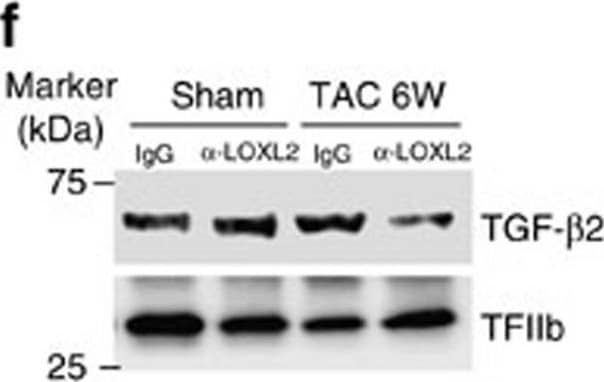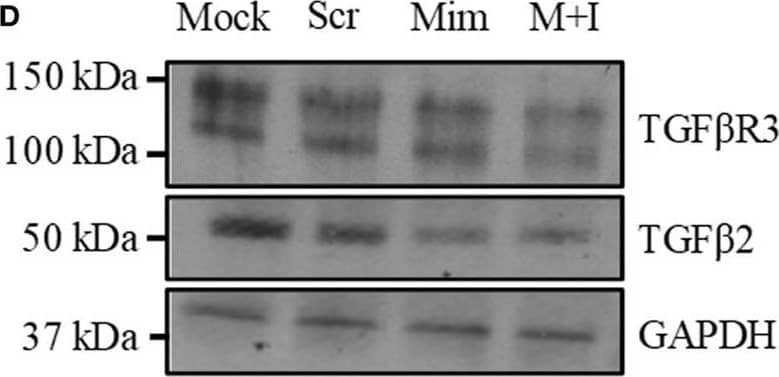Mouse TGF-beta 2 Antibody
R&D Systems, part of Bio-Techne | Catalog # MAB73461

Key Product Details
Validated by
Biological Validation
Species Reactivity
Validated:
Mouse
Cited:
Human, Mouse
Applications
Validated:
Immunohistochemistry, Western Blot
Cited:
Immunohistochemistry, Western Blot
Label
Unconjugated
Antibody Source
Monoclonal Rat IgG2B Clone # 771244
Product Specifications
Immunogen
Chinese hamster ovary cell line CHO-derived recombinant mouse TGF-beta 2
Ala303-Ser414
Accession # P27090
Ala303-Ser414
Accession # P27090
Specificity
Detects mouse TGF‑ beta2 in ELISAs and Western blots. In direct ELISAs, 100% cross‑reactivity with recombinant human (rh) TGF‑ beta2, 25% cross‑reactivity with rhTGF‑ beta3, and no cross‑reactivity with recombinant mouse TGF‑ beta1 is observed.
Clonality
Monoclonal
Host
Rat
Isotype
IgG2B
Scientific Data Images for Mouse TGF-beta 2 Antibody
Detection of Human and Mouse TGF‑ beta2 by Western Blot.
Western blot shows lysates of Y-79 human retinoblastoma cell line, HUVEC human umbilical vein endothelial cells, NIH-3T3 mouse embryonic fibroblast cell line, 4T1 mouse breast cancer cell line, and NMuMG mouse mammary gland epithelial cell line. PVDF membrane was probed with 2 µg/mL of Rat Anti-Mouse TGF-beta 2 Monoclonal Antibody (Catalog # MAB73461) followed by HRP-conjugated Anti-Rat IgG Secondary Antibody (Catalog # HAF005). A specific band was detected for TGF-beta 2 at approximately 52 kDa (as indicated). This experiment was conducted under reducing conditions and using Immunoblot Buffer Group 1.TGF‑ beta2 in Mouse Embryo.
TGF-beta 2 was detected in immersion fixed frozen sections of mouse embryo (15 d.p.c.) using Rat Anti-Mouse TGF-beta 2 Monoclonal Antibody (Catalog # MAB73461) at 25 µg/mL overnight at 4 °C. Tissue was stained using the Anti-Rat HRP-DAB Cell & Tissue Staining Kit (brown; Catalog # CTS017) and counterstained with hematoxylin (blue). Specific staining was localized to neuronal processes. View our protocol for Chromogenic IHC Staining of Frozen Tissue Sections.Detection of Human TGF-beta 2 by Western Blot
LOXL2 acts with TGF-beta through PI3K/ATK/mTORC1 signalling to control myofibroblast transformation and migration.(a) Western blot analysis of LOXL2, SMAD2, p-SMAD2 and GAPDH in human primary cardiac fibroblasts transfected with control (Ctrl) or LOXL2 siRNA. (b) Quantification of TGF-beta isoforms in the culture media of human primary cardiac fibroblasts transfected with control or LOXL2 siRNA (n=4). P value: Student's t-test. Error bar: s.e.m. (c) Changes of COLA1, alpha-SMA and FN1 mRNA in human primary cardiac fibroblasts transfected with control (Ctrl) or LOXL2 siRNA. (d) Western blot of LOXL2, p-AKT, AKT, p-S6K, S6K and p-4E-BP1 with or without PI3K inhibitors LY294002/PI828 (10 μM each), PI3K alpha inhibitors A66/BYL719 and mTORC1 inhibitor Rapamycine (0.1 μM) in cells infected with Ad_GFP/Ad_LOXL2. (e) TGF-beta 2 protein in the culture media (n=4). P value: Student's t-test. Error bar: s.e.m. (f,g) Western blot (f) and quantification (g) of TGF-beta 2 protein in the mice heart ventricles 6 weeks after sham/TAC operation. n=4 mice per group. P value: Student's t-test. Error bar: s.e.m. (h) A signalling cascade from LOXL2 to PI3K/AKT/mTORC1 to TGF-beta 2 translation. (i) Representative phase-contrast image of human primary cardiac fibroblasts 72 h after transfection with control (Ctrl) or LOXL2 siRNA. Scale bars, 50 μm. (j) Immunostaining of Col1A in IgG1- or alpha-LOXL2-treated mice 10 weeks (10W) after sham or TAC operation. Scale bars, 100 μm. Blue: haematoxylin. Brown: Col1A. (k,l) Gap closure assay of fibroblast migration in control, TGF-beta 2, alpha-LOXL2 (k) groups and quantification of cells migrating into the gap (l). Scale bars, 200 μm. n=5–10, P value: Student's t-test. Error bar: s.e.m. Image collected and cropped by CiteAb from the following publication (https://pubmed.ncbi.nlm.nih.gov/27966531), licensed under a CC-BY license. Not internally tested by R&D Systems.Applications for Mouse TGF-beta 2 Antibody
Application
Recommended Usage
Immunohistochemistry
8-25 µg/mL
Sample:
Sample:
Immersion fixed frozen sections of mouse embryo (15 d.p.c.)
Western Blot
2 µg/mL
Sample: Y‑79 human retinoblastoma cell line, HUVEC human umbilical vein endothelial cells, NIH‑3T3 mouse embryonic fibroblast cell line, 4T1 mouse breast cancer cell line, and NMuMG mouse mammary gland epithelial cell line
Sample: Y‑79 human retinoblastoma cell line, HUVEC human umbilical vein endothelial cells, NIH‑3T3 mouse embryonic fibroblast cell line, 4T1 mouse breast cancer cell line, and NMuMG mouse mammary gland epithelial cell line
Formulation, Preparation, and Storage
Purification
Protein A or G purified from hybridoma culture supernatant
Reconstitution
Sterile PBS to a final concentration of 0.5 mg/mL. For liquid material, refer to CoA for concentration.
Formulation
Lyophilized from a 0.2 μm filtered solution in PBS with Trehalose. *Small pack size (SP) is supplied either lyophilized or as a 0.2 µm filtered solution in PBS.
Shipping
Lyophilized product is shipped at ambient temperature. Liquid small pack size (-SP) is shipped with polar packs. Upon receipt, store immediately at the temperature recommended below.
Stability & Storage
Use a manual defrost freezer and avoid repeated freeze-thaw cycles.
- 12 months from date of receipt, -20 to -70 °C as supplied.
- 1 month, 2 to 8 °C under sterile conditions after reconstitution.
- 6 months, -20 to -70 °C under sterile conditions after reconstitution.
Background: TGF-beta 2
Long Name
Transforming Growth Factor beta 2
Alternate Names
TGFB2, TGFbeta 2
Gene Symbol
TGFB2
UniProt
Additional TGF-beta 2 Products
Product Documents for Mouse TGF-beta 2 Antibody
Product Specific Notices for Mouse TGF-beta 2 Antibody
For research use only
